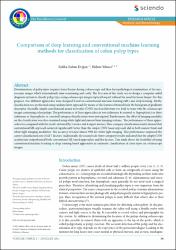| dc.contributor.author | Dogan, Refika Sultan | |
| dc.contributor.author | Yilmaz, Bulent | |
| dc.date.accessioned | 2021-12-07T07:20:24Z | |
| dc.date.available | 2021-12-07T07:20:24Z | |
| dc.date.issued | 2021 | en_US |
| dc.identifier.issn | 2564-615X | |
| dc.identifier.uri | https //doi.org/10.2478/ebtj-2021-0006 | |
| dc.identifier.uri | https://hdl.handle.net/20.500.12573/1068 | |
| dc.description.abstract | Determination of polyp types requires tissue biopsy during colonoscopy and then histopathological examination of the microscopic images which tremendously time-consuming and costly. The first aim of this study was to design a computer-aided diagnosis system to classify polyp types using colonoscopy images (optical biopsy) without the need for tissue biopsy. For this purpose, two different approaches were designed based on conventional machine learning (ML) and deep learning. Firstly, classification was performed using random forest approach by means of the features obtained from the histogram of gradients descriptor. Secondly, simple convolutional neural networks (CNN) based architecture was built to train with the colonoscopy images containing colon polyps. The performances of these approaches on two (adenoma & serrated vs. hyperplastic) or three (adenoma vs. hyperplastic vs. serrated) category classifications were investigated. Furthermore, the effect of imaging modality on the classification was also examined using white-light and narrow band imaging systems. The performance of these approaches was compared with the results obtained by 3 novice and 4 expert doctors. Two-category classification results showed that conventional ML approach achieved significantly better than the simple CNN based approach did in both narrow band and white-light imaging modalities. The accuracy reached almost 95% for white-light imaging. This performance surpassed the correct classification rate of all 7 doctors. Additionally, the second task (three-category) results indicated that the simple CNN architecture outperformed both conventional ML based approaches and the doctors. This study shows the feasibility of using conventional machine learning or deep learning based approaches in automatic classification of colon types on colonoscopy images. | en_US |
| dc.language.iso | eng | en_US |
| dc.publisher | SCIENDOBOGUMILA ZUGA 32A, WARSAW, MAZOVIA, POLAND | en_US |
| dc.relation.isversionof | 10.2478/ebtj-2021-0006 | en_US |
| dc.rights | info:eu-repo/semantics/openAccess | en_US |
| dc.title | Comparison of deep learning and conventional machine learning methods for classification of colon polyp types | en_US |
| dc.type | article | en_US |
| dc.contributor.department | AGÜ, Mühendislik Fakültesi, Elektrik - Elektronik Mühendisliği Bölümü | en_US |
| dc.contributor.institutionauthor | Dogan, Refika Sultan | |
| dc.contributor.institutionauthor | Yilmaz, Bulent | |
| dc.identifier.volume | Volume 5 Issue 1 Page 34-42 | en_US |
| dc.relation.journal | SCIENDOBOGUMILA ZUGA 32A, WARSAW, MAZOVIA, POLAND | en_US |
| dc.relation.publicationcategory | Makale - Uluslararası - Editör Denetimli Dergi | en_US |


















